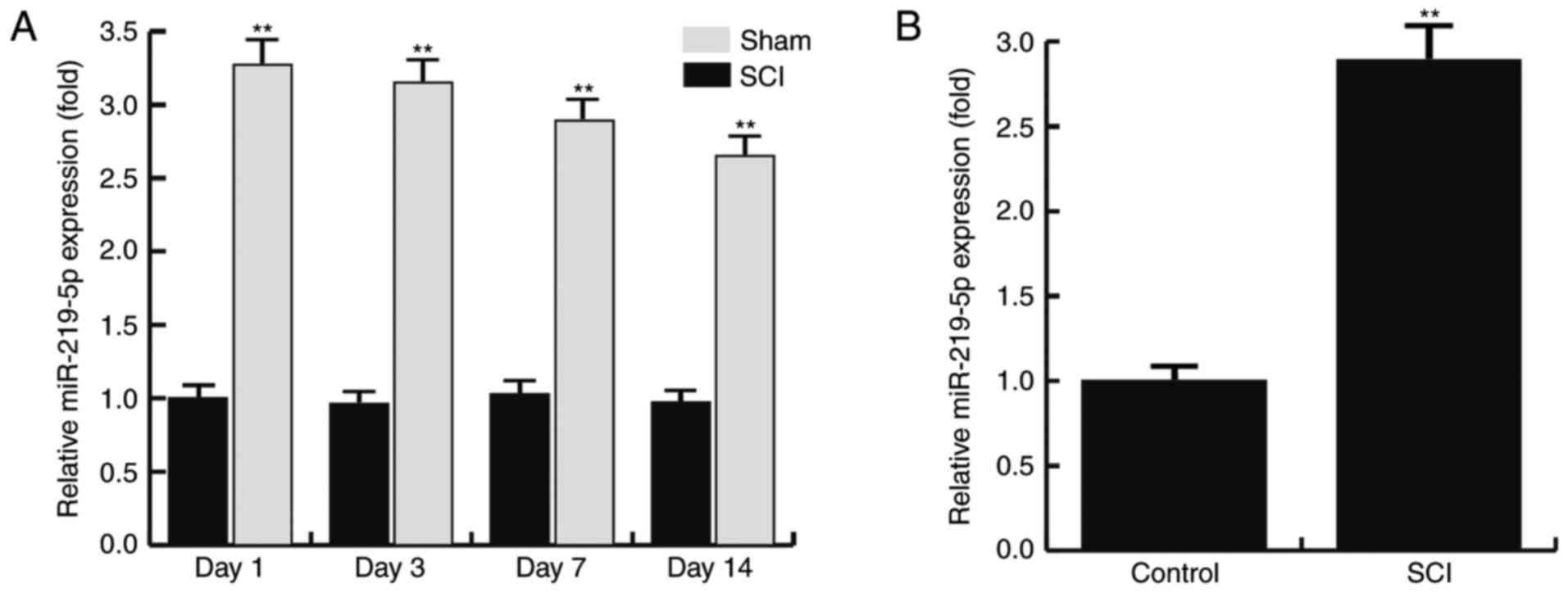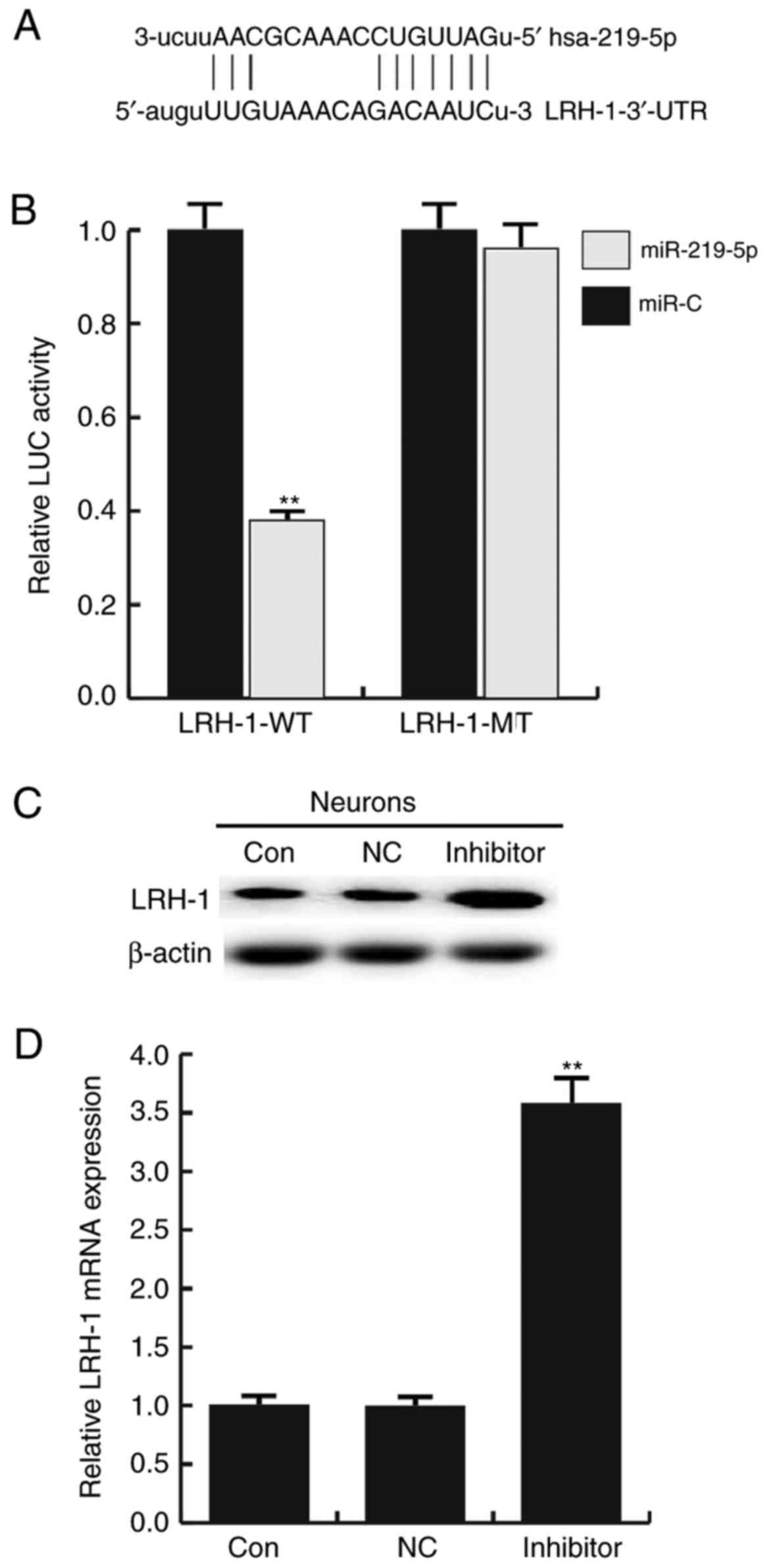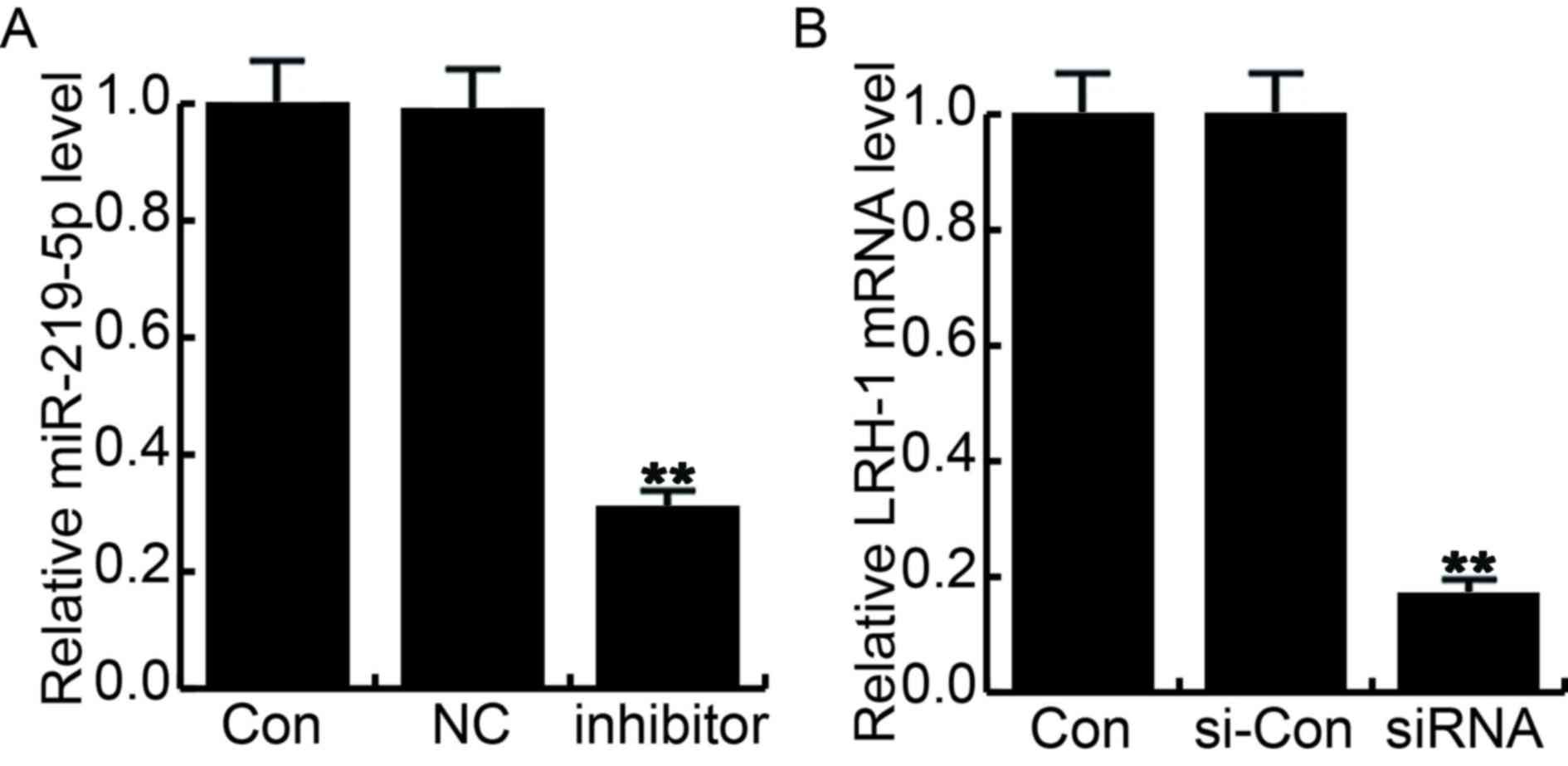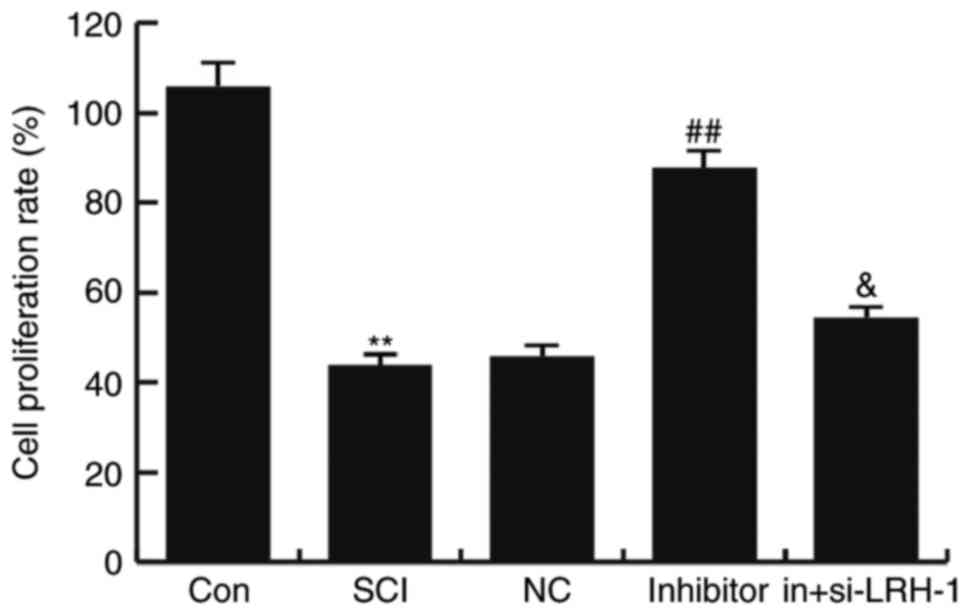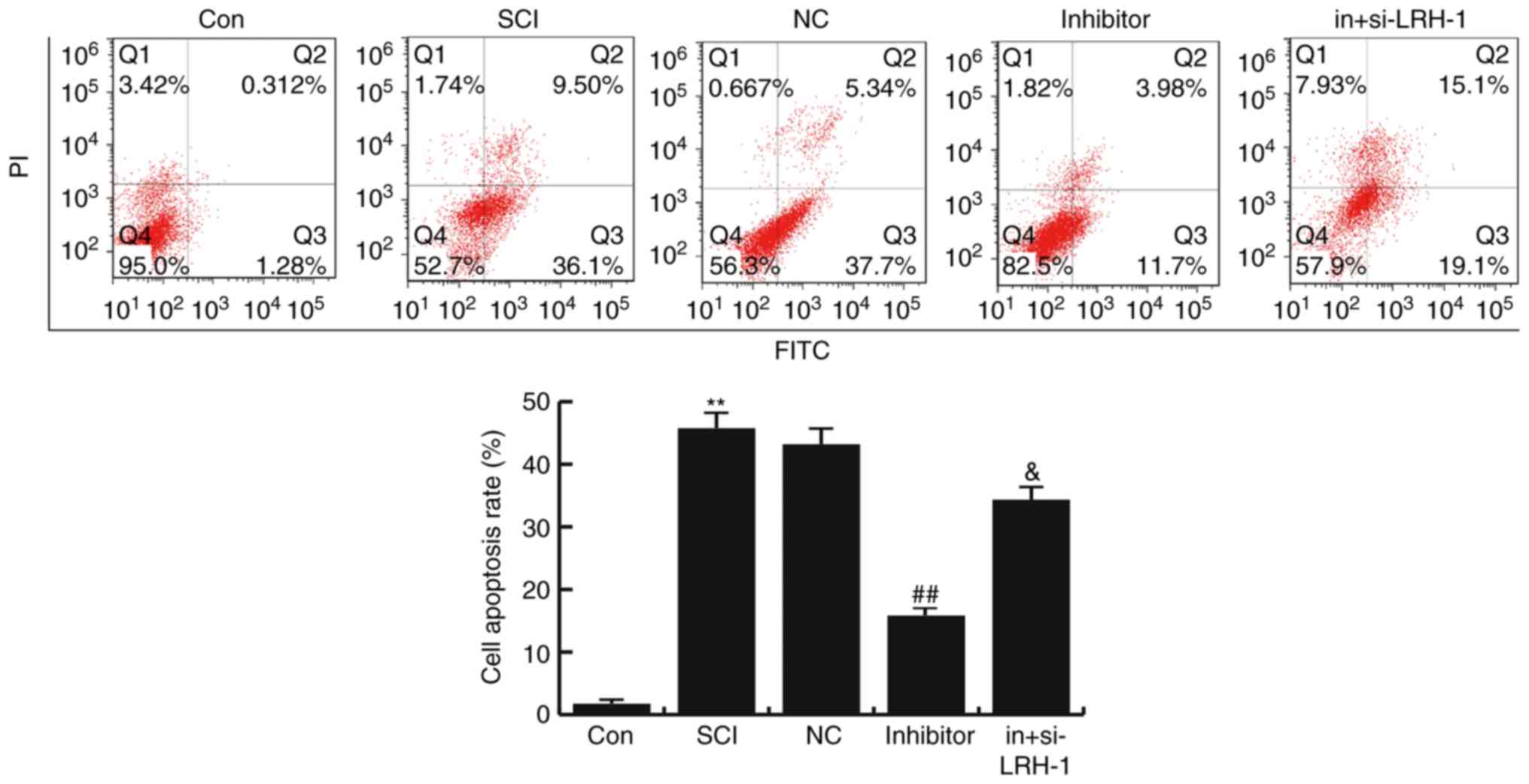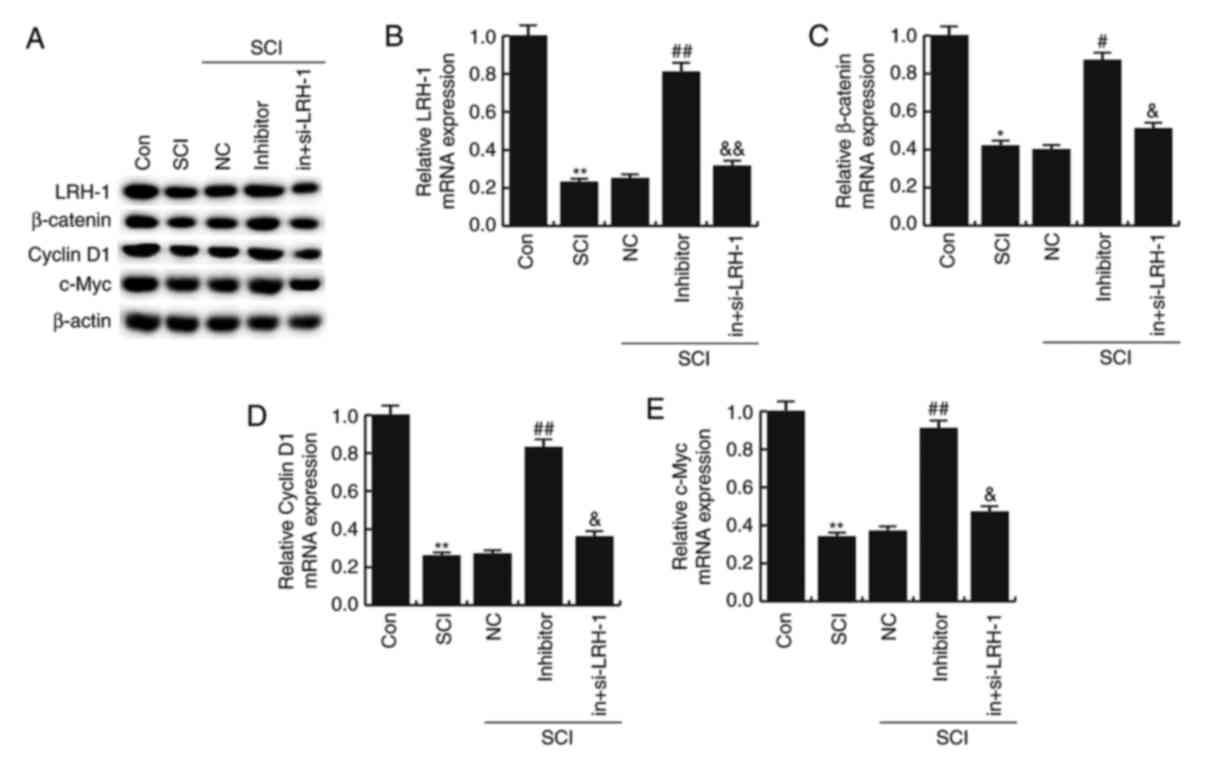Protective role of microRNA‑219‑5p inhibitor against spinal cord injury via liver receptor homolog‑1/Wnt/β‑catenin signaling pathway regulation
- Authors:
- Published online on: February 1, 2018 https://doi.org/10.3892/etm.2018.5829
- Pages: 3563-3569
Abstract
Introduction
As a severe central nervous system disease, spinal cord injury (SCI) may lead to the complete or incomplete loss of motor and sensory functions (1). Damages caused by SCI can be divided into two phases, namely the primary and secondary phases, which include spinal cord blood flow reduction, excessive inflammatory response and neuron apoptosis (2,3). Approximately 250,000-500,000 individuals are reported to suffer from SCI worldwide each year (4). Although various therapeutic strategies have been applied for SCI treatment, including methylprednisolone administration and cell transplantation, there is currently no effective therapeutic method for this injury (5,6). Thus, it is urgent to develop a novel and effective therapeutic method for SCI.
MicroRNAs (miRNAs or miRs), a family of endogenous small no-coding RNA molecules with a length of 18–22 nucleotides, are widely expressed in eukaryotes and serve important roles in gene regulation by binding to the 3′-untranslated region (3′UTR) of their target genes (7). Evidence has demonstrated that miRNAs are involved in many developmental and cellular processes in eukaryotic organisms (8,9). Due to their key roles in the regulation of gene expression, cell differentiation, proliferation and apoptosis, miRNAs have been observed to participate in various neurological diseases (10,11). Furthermore, an increasing number of studies have suggested that miRNA serve an important role in the development of SCI (12–14).
miR-219-5p has been identified as a tumor suppressor in several types of cancer, including colorectal cancer, gastric cancer, papillary thyroid carcinoma and hepatocellular (15–18). In addition, a previous study has revealed a high expression of miR-219-5p in SCI (19); however, the exact role of miR-219-5p in SCI remains unclear. Therefore, the present study aimed to investigate the role of miR-219-5p in SCI and to further examine the underlying molecular mechanism.
Materials and methods
Animals and establishment of an SCI model in mice and neurons
Healthy adult male ICR mice (Sino-British SIPPR/BK Lab Animal Ltd., Shanghai, China) weighing ~30 g (6 weeks of age) were fed under a controlled environment, and provided with free access to standard rodent chow and water. Mice were maintained under a 12-h light/dark cycle, and the room temperature and relative humidity were set at 25±3°C and 60±15%, respectively. All experiments were performed in accordance with ethical standards of the Third Hospital of Hebei Medical University (Shijiazhuang, China), and were approved by the Ethics Committee Review Board of this institution.
Mice were randomly divided into two groups (n=10 per group), including the sham and SCI groups. The SCI model was established as previously described (20). Briefly, the mice were anesthetized by intraperitoneally injection with 10% chloral hydrate (30 mg/kg). Following anesthetization, the mice were placed on table at a prone position and an incision along the spine was made across the skin, subcutis and muscle. Subsequently, a thoracic (T) 11-lumbar (L) 1 laminectomy was performed to expose the spinal cord. Following L1 laminectomy, the contusion injury was extended to the T11 spinal cord. Subsequent to the contusion surgery, the skin was immediately sutured. Mice in the sham group received a dorsal laminectomy only. Mice were kept warm and allowed to recover from the anesthesia. The majority of SCI mice presented flaccid paralysis in the lower extremities, and other SCI mice displayed spastic symptoms. Mice presenting with flaccid paralysis were used in subsequent experiments in the present study.
Following the sacrifice of mice, the spinal cord at L4-6 from SCI mice and the control mice was isolated, and the tissue was then digested with 0.125% trypsin containing 0.02% EDTA at 37°C for 20 min. Next, Dulbecco's modified Eagle medium was added to stop the digestion. The tissues were then used for miR-219-5p detection using reverse transcription-quantitative polymerase chain reaction (RT-qPCR), and for neuron extraction and purification. Neurons were isolated and purified from the spinal cords from the sham mice as previously described (21). Neurons (3×104/cm2) were plated into 35-mm petri plates coated with polylysine. Subsequently, 2 ml neurobasal culture medium (Invitrogen; Thermo Fisher Scientific, Inc.) supplemented with glutamine, B27 and penicillin/streptomycin was added to the plates, and the neurons were grown in an incubator at 37°C with 5% CO2. An SCI model in neurons was established by scratch according to previous study (22), and neurons without any treatment were used as the control group. At 24 h after scratching, neurons were harvested for subsequent analysis.
Cell transfection
A transfection assay was performed using Lipofectamine 2000 regent (Thermo Fisher Scientific, Inc., Waltham, MA, USA). Neurons were transiently transfected with miR-219-5p inhibitors (GenePharma, Shanghai, China), the negative control of miR-219-5p inhibitors (NC) (GenePharma), small interfering (si)RNA (si)-liver receptor homolog-1 (LRH-1) (Santa Cruz Biotechnology, Inc., Dallas, CA, USA), control siRNA (the control of LRH-1 siRNA) (Santa Cruz Biotechnology, Inc.) or miR-219-5p inhibitor + LRH-1 siRNA (in+si-LRH-1) using Lipofectamine® 2000 (Invitrogen; Thermo Fisher Scientific, Inc.) according with the manufacturer's protocol. Cells without any treatment were used as the control (Con) group. The transfection efficiency was determined by RT-qPCR.
MTT assay
At 48 h after cell transfection, an MTT assay was performed to investigate the neuron viability. Briefly, the neurons were seeded into 96-well plates (Costar; Corning Incorporated, Corning, NY, USA) at a density of 2.0×103 cells per well and incubated for ~24 h before treatment. A total of 24 h later, 20 µl MTT (Sigma-Aldrich; Merck KGaA, Darmstadt, Germany) solution at a concentration of 5 mg/ml was added to each well, and then incubated for a further 4 h at 37°C. Finally, the cell proliferation ability was assessed by measuring the optical density at 490 nm using a microplate reader (Thermo Fisher Scientific, Inc.).
Apoptosis analysis assay
An Annexin V-FITC Early Apoptosis Detection Kit (cat. no. 6592; Cell Signaling Technology, Inc., Danvers, MA, USA) was used to detect cell apoptosis. Briefly, at 48 h after cell transfection, the neurons were harvested with trypsin, re-suspended in Annexin V-FITC/propidium iodide, and then incubated for ~15 min at room temperature in the dark. A BD FACSCelesta™ flow cytometer (BD Biosciences, Franklin Lakes, NJ, USA) was subsequently conducted to assess the apoptotic rate of cells in different groups in line with the instrument's operating protocol. Data were analyzed using version 2.5 WinMDI (Purdue University Cytometry Laboratories; http://www.cyto.purdue.edu/flowcyt/software/Catalog.htm).
Bioinformatics and dual-luciferase reporter analyses
Bioinformatics prediction was performed to identify potential target genes of miR-219-5p, including LRH-1, which were selected using miRNA target site prediction software (http://www.microrna.org).
In order to examine whether miR-219-5p targets the 3′UTR of LRH-1, a cDNA fragment of the LRH-1-3′UTR mRNA containing the seed sequence of the wild-type (WT) miR-219-5p binding site or a mutated (MUT) binding site of the 3′UTR sequence was cloned into the pmirGLO dual-luciferase vector (Promega Corp., Madison, WI, USA). The psiCHECK-2 reporter plasmid (Sangon Biotech Co., Ltd., Shanghai, China) vectors were termed LRH-1-3′UTR-WT and LRH-1-3′UTR-MUT, respectively. Subsequently, neurons were seeded into a 24-well plate (5×104 cells/well), and co-transfected with LRH-1-3′UTR-WT or LRH-1-3′UTR-MUT and with miR-219-5p mimic or its control (mimic control) vector (GenePharma, Shanghai, China). The luciferase activity was then analyzed using a Dual-Luciferase Reporter Assay kit (Promega Corp.) following the manufacturer's protocols, and normalized to Renilla luciferase activity. Each experiment was repeated at least three times.
RT-qPCR analysis
Total RNA from the spinal cord tissue and neurons was extracted using the TRIzol reagent (Thermo Fisher Scientific, Inc.) as per the manufacturer's protocol. The RevertAid First Strand cDNA synthesis kit (Fermentas; Thermo Fisher Scientific, Inc.) was used to reverse transcribe the total RNA into cDNA. qPCR was subsequently performed using the SYBR Green qRCR Mix (Toyobo Life Science, Osaka, Japan). U6 was used as an internal reference for the determination of miRNA expression, while GAPDH served as the internal reference for the detection of mRNA expression. The following primer sequences were synthesized by GenScript (Piscataway, NJ, USA): LRH-1, forward 5′-GCACGGACTTACACCTATTGTG-3′ and reverse 5′-TGTCAATTTGGCAGTTCTGG-3′; β-catenin, forward 5′-AACAGGGTCTGGGACATTAGTC-3′ and reverse 5′-CGAAAGCCAATCAAACACAAAC-3′; c-Myc, forward 5′-CACCAGCAGCGACTCTGA-3′ and 5′-GATCCAGACTCTGACCTTTTGC-3′; cyclin D1, forward 5′-AACTACCTGGACCGCTTCCT-3′ and reverse 5′-CCACTTGAGCTTGTTCACCA-3′; GAPDH, forward 5′-GAAATCCCATCACCATCTTCCAGG-3′ and reverse 5′-GAGCCCCAGCCTTCTCCATG-3′; miR-219-5p, forward 5′-ACACTCCAGCTGGGTGATTGTCCAAACGCAAT-3′ and reverse 5′-CTCAACTGGTGTCGTGGA-3′; and U6, forward 5′-GCTTCGGCAGCACATATACTAAAAT-3′ and reverse 5′-CGCTTCACGAATTTGCGTGTCAT-3′. The following thermocycling conditions were performed: 95°C for 5 min, followed by 40 cycles of denaturation at 95°C for 15 sec and annealing/elongation at 60°C for 30 sec. Relative gene expression was calculated by using the 2−ΔΔCq method (23). All experiments were repeated at least three times.
Western blot analysis
To collect the total cell protein, neurons were lysed on ice with the radioimmunoprecipitation assay lysis buffer (Auragene Bioscience, Changsha, China). Protein concentration was determined using the BCA assay kit (Beyotime Institute of Biotechnology). Protein samples were separated by 12% SDS-PAGE, and then transferred onto nitrocellulose membranes. Subsequent to blocking with 5% non-fat milk at room temperature for 1.5 h, the membranes were incubated overnight at 4°C with primary antibodies against LRH-1 (cat no. #12800), β-catenin (cat no. #8480), Cyclin D1 (cat no. #2978), c-Myc (cat no. #13978) and β-actin (cat no. 4970) (All dilutions, 1:1,000; Cell Signaling Technology, Inc., Danvers, MA, USA). Next, the membranes were incubated with anti-rabbit immunoglobulin G horseradish peroxidase-coupled secondary antibody (cat no. 7074; 1:1,000 dilution; Cell Signaling Technology, Inc.) at room temperature for ~1 h. Subsequent to washing three times with Tris-buffered saline/Tween-20, the membranes were stained with an enhanced chemiluminescent reagent (Applygen Technologies, Inc., Beijing, China) according to the manufacturer's protocol, and the western blot bands were observed using a ChemiDoc XRS+ System (Bio-Rad Laboratories, Inc., Hercules, CA, USA).
Statistical analysis
Data are presented as the mean ± standard deviation. Statistical analyses were performed using SPSS version 16.0 (SPSS Inc., Chicago, IL, USA). The variations between groups were statistically examined using the Student's t-test or one-way analysis of variance. P<0.05 was considered to be an indication of a statistically significant difference.
Results
SCI upregulates the level of miR-219-5p in the spinal cords of mice
The expression level of miR-219-5p in the spinal cord at 1, 3, 7 and 14 days after SCI was detected using RT-qPCR. The results revealed that the relative expression of miR-219 in the sham rats exhibited no significant alterations between days 1 and 14 after SCI. However, compared with the sham group, the level of miR-219-5p in the SCI rats was significantly increased at day 1 after SCI, and this increase was maintained until day 14 post-injury (Fig. 1A). Furthermore, the level of miR-219-5p in the control and SCI model neurons were also determined by RT-qPCR. The results demonstrated that, compared with the control neurons, the level of miR-219-5p was significantly upregulated in the SCI model neurons (Fig. 1B). The data indicated that the level of miR-219-5p was upregulated in spinal cords.
LRH-1 is a target gene of miR-219-5p
An miRNA target site prediction software was used to predict the target genes of miR-219-5p. In total, ~4,300 target genes were identified to be the potential target genes of miR-219-5p, including LRH-1 (Fig. 2A). Based on our previous studies and the literature analysis, it was determined that LRH-1 is involved in a variety of biological progress, and regulates cell proliferation, apoptosis and cell cycle by modulating the Wnt/β-catenin and p53 signaling pathways (16,24,25). However, whether this gene is involved in SCI remains unclear. Thus, LRH-1 was selected for further investigation in the present study.
Subsequently, a dual-luciferase reporter assay was conducted to confirm whether miR-219-5p directly targets LRH-1. As shown in Fig. 2B, compared with the control (miR-C) group, the luciferase activity of cells transfected with the LRH-1-3′UTR-WT vector was significantly reduced (P<0.01). However, no evident difference in fluorescence was observed between the LRH-1-3′UTR-MUT and the control groups.
To further determine whether miR-219-5p regulates LRH-1 expression in neurons, the effect of an miR-219-5p inhibitor on LRH-1 expression in neurons was investigated. Neurons were transfected with miR-219-5p inhibitor, NC, LRH-1 siRNA, or control siRNA. It was indicated that the miR-219-5p inhibitor significantly enhanced the protein (Fig. 2C) and mRNA (Fig. 2D) expression levels of LRH-1 in neurons as compared with the control and the NC-transfected cells. Additionally, the transfection efficiency was determined by RT-qPCR (Fig. 3). Taken together, the findings suggested that LRH-1 is a target gene of miR-219-5p and it was negatively regulated by miR-219-5p.
miR-219-5p inhibitor rescues the SCI-induced neuron activity inhibition
To detect the influence of miR-219-5p inhibitor on neuron activity, the neuron viability was determined using an MTT assay. The results demonstrated that, compared with the control group (untreated control cells), the viability of neurons was markedly reduced in the SCI group (P<0.01; Fig. 4). This decreased viability was rescued by miR-219-5p inhibitor treatment, which significantly increased the cell proliferation rate compared with the SCI group (P<0.01). In addition, transfection with siRNA-LRH-1 for knockdown of LRH-1 expression eliminated the increased neuron viability caused by the miR-219-5p inhibitor (Fig. 4). These findings suggest that miR-219-5p inhibitor could rescue SCI-induced neuron activity inhibition.
miR-219-5p inhibitor inhibits the SCI-induced neuronal apoptosis
To determine the effects of miR-219-5p on neuronal apoptosis, the apoptosis of cells was analyzed by FCM assay. Compared with the control group, the number of apoptotic cells was significantly enhanced in the SCI group, while this SCI-induced increase was then inhibited by miR-219-5p inhibitor treatment (both P<0.01). Furthermore, it was observed that si-LRH-1 eliminated the decreased neuron apoptosis caused by the miR-219-5p inhibitor, and this change was statistically significant (P<0.05; Fig. 5). The data indicated that miR-219-5p inhibitor could inhibit the SCI-induced neuronal apoptosis.
miR-219-5p inhibitor rescues the LRH-1/Wnt/β-catenin inhibition induced by SCI
To further determine the underlying molecular mechanisms of the effect of miR-219-5p on SCI development, the LRH-1/Wnt/β-catenin pathway was analyzed. The protein and mRNA levels of LRH-1, β-catenin, Cyclin D1 and c-Myc in different groups were detected using western blotting and RT-qPCR, respectively. As illustrated in Fig. 5, the mRNA levels of LRH-1, β-catenin, Cyclin D1 and c-Myc in SCI neurons were markedly lower compared with the control group (P<0.05 or P<0.01). However, the miR-219-5p inhibitor prevented this SCI-induced reduction of LRH-1, β-catenin, Cyclin D1 and c-Myc levels (P<0.05 or P<0.01; Fig. 6). In addition, LRH-1 gene silencing by siRNA transfection eliminated the increased mRNA expression levels of LRH-1, β-catenin, Cyclin D1 and c-Myc caused by miR-219-5p inhibitor in the neurons (P<0.05; Fig. 6). Similar results were obtained from western blot analysis. MiR-219-5p inhibitor rescued the LRH-1/Wnt/β-catenin inhibition induced by SCI.
Discussion
SCI is considered to be a severe disease that affects a great number of individuals worldwide. Previous evidence has revealed that apoptosis and neuroplasticity contribute to the functional defects in patients with SCI (26). Although the pathophysiological processes of SCI have been extensively studied, there are currently no effective treatments for patients with SCI (22).
miRNAs are small, non-coding RNAs that suppress mRNA translation or induce mRNA degradation by binding to the 3′UTR of mRNA targets. In recent years, the potential roles that miRNA may serve in the development and progression of SCI have been reported (27–33). To date, various miRNAs have been observed to be abnormally expressed in SCI patients and to serve critical roles in the development of SCI (27). Liu et al (28) reported that inhibition of miR-223 exerted a protective role in functional recovery, angiogenesis and anti-apoptosis during SCI. In addition, Yang et al (29) suggested that downregulation of miR-128 in murine microglial cells may contribute to the development of neuropathic pain following SCI via the activation of p38. Zhou et al (30) also demonstrated that miR-199b relieved SCI, at least partly, through regulating the IKKβ-NF-kB signaling pathway and influencing the microglia function. miR-195 has been observed to be decreased following SCI, and may protect rats from SCI (31). Furthermore, miR-208b participated in SCI progression via modulating myostatin expression (32). Wang et al (33) also considered that miR-142-3p was a key therapeutic target for repairing the sensory function in SCI.
miR-219-5p, which has been widely investigated in several cancer processes (15–18,34,35), was reported to be highly expressed in SCI (19). However, to date, the exact role of miR-219-5p in SCI remains unclear. Therefore, the present study investigated the role of miR-219-5p in SCI using a mouse/neuron SCI model. The results revealed that the miR-219-5p inhibitor resulted in the recovery of SCI-induced neuron activity inhibition, as well as inhibited the SCI-induced neuron apoptosis. In addition, the study revealed that LRH-1 was a direct target of miR-219-5p. LRH-1 has been suggested as a coactivator of the Wnt/β-catenin signaling pathway, and it can interact with transcription factor 4 and β-catenin to promote the expression of c-Myc and cyclin D1/E1 (36,37). Therefore, β-catenin, cyclin D1 and c-Myc were analyzed in the present study. The present results suggested that miR-219-5p inhibitor was able to reverse the inhibition of the LRH-1/Wnt/β-catenin pathway induced by SCI. Moreover, LRH-1 silencing could eliminate the effects of miR-219-5p inhibitor on SCI.
In conclusion, the present study suggested that the miR-219-5p inhibitor served a protective role in SCI via regulating the LRH-1/Wnt/β-catenin signaling pathway. Thus, miR-219-5p may be used as a novel and potential therapeutic target for SCI treatment. However, the role of miRNA-219-5p in SCI and its associated mechanisms require further extensive research. In the future, it should be also investigated whether miRNA-219-5p serves a role in SCI by regulating other target genes, in order to provide a more comprehensive theoretical basis for the clinical treatment of SCI.
Acknowledgements
The authors would like to thank Dr Yujun Li (Department of Spinal Surgery, the Second Hospital of Tangshan, Tangshan, China) for the assistance in preparing the manuscript.
References
|
Hulsebosch CE: Recent advances in pathophysiology and treatment of spinal cord injury. Adv Physiol Educ. 26:238–255. 2002. View Article : Google Scholar : PubMed/NCBI | |
|
Dumont RJ, Okonkwo DO, Verma S, Hurlbert RJ, Boulos PT, Ellegala DB and Dumont AS: Acute spinal cord injury, part I: Pathophysiologic mechanisms. Clin Neuropharmacol. 24:254–264. 2001. View Article : Google Scholar : PubMed/NCBI | |
|
Bareyre FM and Schwab ME: Inflammation, degeneration and regeneration in the injured spinal cord: Insights from DNA microarrays. Trends Neurosci. 26:555–563. 2003. View Article : Google Scholar : PubMed/NCBI | |
|
Ozdemir M, Attar A and Kuzu I: Regenerative treatment in spinal cord injury. Curr Stem Cell Res Ther. 7:364–369. 2012. View Article : Google Scholar : PubMed/NCBI | |
|
Pereira JE, Costa LM, Cabrita AM, Couto PA, Filipe VM, Magalhães LG, Fornaro M, Di Scipio F, Geuna S, Maurício AC and Varejão AS: Methylprednisolone fails to improve functional and histological outcome following spinal cord injury in rats. Exp Neurol. 220:71–81. 2009. View Article : Google Scholar : PubMed/NCBI | |
|
Bartel DP: MicroRNAs: Genomics, biogenesis, mechanism, and function. Cell. 116:281–297. 2004. View Article : Google Scholar : PubMed/NCBI | |
|
Krol J, Loedige I and Filipowicz W: The widespread regulation of microRNA biogenesis, function and decay. Nat Rev Genet. 11:597–610. 2010. View Article : Google Scholar : PubMed/NCBI | |
|
Winter J, Jung S, Keller S, Gregory RI and Diederichs S: Many roads to maturity: microRNA biogenesis pathways and their regulation. Nat Cell Biol. 11:228–234. 2009. View Article : Google Scholar : PubMed/NCBI | |
|
Wang W, Kwon EJ and Tsai LH: MicroRNAs in learning, memory, and neurological diseases. Learn Mem. 19:359–368. 2012. View Article : Google Scholar : PubMed/NCBI | |
|
Rao P, Benito E and Fischer A: MicroRNAs as biomarkers for CNS disease. Front Mol Neurosci. 6:392013. View Article : Google Scholar : PubMed/NCBI | |
|
Dong J, Lu M, He X, Xu J, Qin J, Cheng Z, Liang B, Wang D and Li H: Identifying the role of microRNAs in spinal cord injury. Neurol Sci. 35:1663–1671. 2014. View Article : Google Scholar : PubMed/NCBI | |
|
Ning B, Gao L, Liu RH, Liu Y, Zhang NS and Chen ZY: microRNAs in spinal cord injury: Potential roles and therapeutic implications. Int J Biol Sci. 10:997–1006. 2014. View Article : Google Scholar : PubMed/NCBI | |
|
Nieto-Diaz M, Esteban FJ, Reigada D, Muñoz-Galdeano T, Yunta M, Caballero-López M, Navarro-Ruiz R, Del Águila A and Maza RM: microRNA dysregulation in spinal cord injury: Causes, consequences and therapeutics. Front Cell Neurosci. 8:532014. View Article : Google Scholar : PubMed/NCBI | |
|
Wang Q, Zhu L, Jiang Y, Xu J, Wang F and He Z: miR-219-5p suppresses the proliferation and invasion of colorectal cancer cells by targeting calcyphosin. Oncol Lett. 13:1319–1324. 2017. View Article : Google Scholar : PubMed/NCBI | |
|
Li C, Dong J, Han Z and Zhang K: MicroRNA-219-5p represses the proliferation, migration and invasion of gastric cancer cells by targeting the LRH-1/Wnt/β-catenin signaling pathway. Oncol Res. 25:617–627. 2017. View Article : Google Scholar : PubMed/NCBI | |
|
Huang C, Cai Z, Huang M, Mao C, Zhang Q, Lin Y, Zhang X, Tang B, Chen Y, Wang X, et al: miR-219-5p modulates cell growth of papillary thyroid carcinoma by targeting estrogen receptor α. J Clin Endocrinol Metab. 100:E204–E213. 2015. View Article : Google Scholar : PubMed/NCBI | |
|
Huang N, Lin J, Ruan J, Su N, Qing R, Liu F, He B, Lv C, Zheng D and Luo R: MiR-219-5p inhibits hepatocellular carcinoma cell proliferation by targeting glypican-3. FEBS Lett. 586:884–891. 2012. View Article : Google Scholar : PubMed/NCBI | |
|
Hachisuka S, Kamei N, Ujigo S, Miyaki S, Yasunaga Y and Ochi M: Circulating microRNAs as biomarkers for evaluating the severity of acute spinal cord injury. Spinal Cord. 52:596–600. 2014. View Article : Google Scholar : PubMed/NCBI | |
|
Jee MK, Jung JS, Choi JI, Jang JA, Kang KS, Im YB and Kang SK: MicroRNA 486 is a potentially novel target for the treatment of spinal cord injury. Brain. 135:1237–1252. 2012. View Article : Google Scholar : PubMed/NCBI | |
|
Jaworski J and Sheng M: The growing role of mTOR in neuronal development and plasticity. Mol Neurobiol. 34:205–219. 2006. View Article : Google Scholar : PubMed/NCBI | |
|
Wang Z, Zhou L, Zheng X, Chen G, Pan R, Li J and Liu W: Autophagy protects against PI3K/Akt/mTOR-mediated apoptosis of spinal cord neuronsafter mechanical injury. Neurosci Lett. 656:158–164. 2017. View Article : Google Scholar : PubMed/NCBI | |
|
Livak KJ and Schmittgen TD: Analysis of relative gene expression data using real-time quantitative PCR and the 2(-Delta Delta C(T)) method. Methods. 25:402–408. 2001. View Article : Google Scholar : PubMed/NCBI | |
|
Zhai G, Song J, Shu T, Yan J, Jin X, He J and Yin Z: LRH-1senses signaling from phosphatidylcholine to regulate the expansion growth of digestive organs via synergy with Wnt/β-catenin signaling in zebrafish. J Genet Genomics. 20:307–317. 2017. View Article : Google Scholar | |
|
Kramer HB, Lai CF, Patel H, Periyasamy M, Lin ML, Feller SM, Fuller-Pace FV, Meek DW, Ali S and Buluwela L: LRH-1 drives colon cancer cell growth by repressing the expression of the CDKN1A gene in a p53-dependent manner. Nucleic Acids Res. 44:582–594. 2016. View Article : Google Scholar : PubMed/NCBI | |
|
Harkema SJ: Neural plasticity after human spinal cord injury: Application of locomotor training to the rehabilitation of walking. Neuroscientist. 7:455–468. 2001. View Article : Google Scholar : PubMed/NCBI | |
|
Martirosyan NL, Carotenuto A, Patel AA, Kalani MY, Yagmurlu K, Lemole GM Jr, Preul MC and Theodore N: The role of microRNA markers in the diagnosis, treatment and outcome prediction of spinal cord injury. Front Surg. 3:562016. View Article : Google Scholar : PubMed/NCBI | |
|
Liu D, Huang Y, Jia C, Li Y, Liang F and Fu Q: Administration of antagomir-223 inhibits apoptosis, promotes angiogenesis andfunctional recovery in rats with spinal cord injury. Cell Mol Neurobiol. 35:483–491. 2015. View Article : Google Scholar : PubMed/NCBI | |
|
Yang Z, Xu J, Zhu R and Liu L: Down-regulation of miRNA-128 contributes to neuropathic pain following spinal cord injury via activation of P38. Med Sci Monit. 23:405–411. 2017. View Article : Google Scholar : PubMed/NCBI | |
|
Zhou HJ, Wang LQ, Xu QS, Fan ZX, Zhu Y, Jiang H, Zheng XJ, Ma YH and Zhan RY: Downregulation of miR-199b promotes the acute spinal cord injury through IKKβ-NF-κB signaling pathway activating microglial cells. Exp Cell Res. 349:60–67. 2016. View Article : Google Scholar : PubMed/NCBI | |
|
Tao B and Shi K: Decreased miR-195 expression protects rats from spinal cord injury primarily by targeting HIF-1α. Ann Clin Lab Sci. 46:49–53. 2016.PubMed/NCBI | |
|
Boon H, Sjögren RJ, Massart J, Egan B, Kostovski E, Iversen PO, Hjeltnes N, Chibalin AV, Widegren U and Zierath JR: MicroRNA-208b progressively declines after spinal cord injury in humans and is inversely related to myostatin expression. Physiol Rep. 3:pii e126222015. View Article : Google Scholar | |
|
Wang T, Yuan W, Liu Y, Zhang Y, Wang Z, Chen X, Feng S, Xiu Y and Li W: miR-142-3p is a potential therapeutic target for sensory function recovery of spinal cord injury. Med Sci Monit. 21:2553–2556. 2015. View Article : Google Scholar : PubMed/NCBI | |
|
Rao SA, Arimappamagan A, Pandey P, Santosh V, Hegde AS, Chandramouli BA and Somasundaram K: miR-219-5p inhibits receptor tyrosine kinase pathway by targeting EGFR in glioblastoma. PLoS One. 8:e631642013. View Article : Google Scholar : PubMed/NCBI | |
|
Cheng J, Deng R, Zhang P, Wu C, Wu K, Shi L, Liu X, Bai J, Deng M, Shuai X, et al: miR-219-5p plays a tumor suppressive role in colon cancer by targeting oncogene Sall4. Oncol Rep. 34:1923–1932. 2015. View Article : Google Scholar : PubMed/NCBI | |
|
Nadolny C and Dong X: Liver receptor homolog-1 (LRH-1): A potential therapeutic target for cancer. Cancer Biol Ther. 16:997–1004. 2015. View Article : Google Scholar : PubMed/NCBI | |
|
Botrugno OA, Fayard E, Annicotte JS, Haby C, Brennan T, Wendling O, Tanaka T, Kodama T, Thomas W, Auwerx J and Schoonjans K: Synergy between LRH-1 and beta-catenin induces G1 cyclin-mediated cell proliferation. Mol Cell. 15:499–509. 2004. View Article : Google Scholar : PubMed/NCBI |



